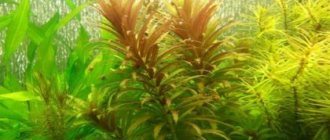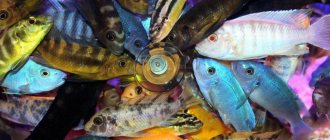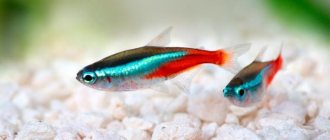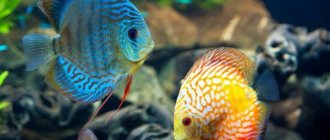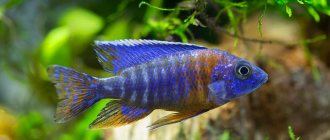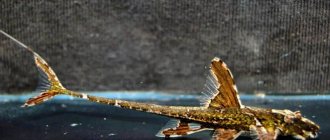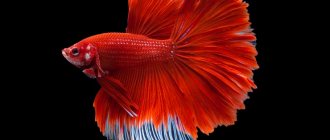Habitat
Originates from the southwestern part of the island of New Guinea from the territory belonging to Indonesia.
It lives in numerous streams and rivers flowing into the Arafura Sea. Found in areas with dense aquatic vegetation and flooded coastlines. The natural habitat is characterized by murky brown waters with a high content of organic matter. Brief information:
- Aquarium volume - from 40 liters.
- Temperature - 18–26°C
- pH value – 6.5–7.5
- Water hardness - soft (2–12 dGH)
- Substrate type - any
- Lighting – dim/moderate
- Brackish water - no
- Water movement - weak/moderate
- The size of the fish is up to 3.5 cm.
- Food - any food, mainly meat
- Temperament - peaceful active
- Keeping in a small group or flock
Pseudomugil paskai red neon
FSB
0
5 517
Share
Pseudomugil pascai red neon is a relatively new fish that was first discovered in 1983. In nature, these fish inhabit the waters of Papua New Guinea and Indonesia. Fish lead a schooling lifestyle, swimming in slow-flowing sections of rivers densely overgrown with aquatic vegetation. In such places the water is very cloudy. The fish are very beautiful and not difficult to keep, so even beginners can handle them.
Pseudomugil paskai red neon has a slender body. The dorsal plumage is orange in color, two-part, the second fin is much larger than the first. All fins, except the pectoral ones, have small dark speckles and are edged with yellow. The tail plumage, in comparison with the general orange color of the whole body, is slightly yellowish. Unlike males, females do not have dark markings on their fins, and their overall coloration is more faded. The maximum size of fish is 3-3.5 cm.
Pseudomugil pascai red neon should be kept in a group of 8-10 individuals, ideally more. In this case, the fish acquire a spectacular color, and the males demonstrate their beauty in front of the females, in the fight for their attention, by straightening all their fins. When keeping fish in smaller numbers, they become overly shy. The aquarium should be densely planted with a variety of plants. You can place bushes of floating plants on the surface of the water, which will serve as a good natural light filter and in their shade the fish will feel much calmer. You can place driftwood and tree branches at the bottom. Fish can be kept in a small aquarium measuring 45x30 cm. If you want to keep adult fish and juveniles in one aquarium, then you need to place several small-leaved moss bushes at the bottom in the midst of which the fry will hide. It is possible to keep Pseudomugil pascai red together with peaceful fish of comparable size, as well as shrimp.
It is necessary to plant fish in a new aquarium only after biological equilibrium has been established in it, since fish are very susceptible to fluctuations in the chemical composition of the water. Water parameters: temperature 18-26°C, hardness dH 2-14°, acidity pH 6.5-7.5. Filtration, aeration and weekly replacement of 1/3 of the aquarium water with fresh water are necessary. It is also advisable to create a small flow of water, for example, by directing the outlet socket of the water filter along one of the long walls of the aquarium.
Under natural conditions, the menu of fish consists of phytoplankton, zooplankton and small invertebrates. In aquarium conditions, fish are fed with daphnia, brine shrimp, and microworms. Fish do not refuse dry floating, pre-crushed food. The fish must be fed at least 2 times a day.
Reproduction
Pseudomugil pascai red neon reaches its sexual maturity by six months of age.
It must be borne in mind that this type of fish does not care for eggs and fry and during spawning they happily eat their eggs. Spawning is stimulated by increasing the water temperature to 28-29°C. Females spawn in portions of several eggs every day for 3-4 days. The eggs are sticky and attach to plant leaves and substrate. The same male can mate with several females in one day. Spawning occurs only during the daytime.
There are two main methods of fish breeding:
- the first involves selecting a small group of fish, consisting of 1 male and 2-3 females, which are placed in a small spawning aquarium with a filter in the form of a foam sponge and a separator net placed on the bottom. The bottom is constantly siphoned several times a day, sucking out the eggs, which are placed in another aquarium. They also check the foam sponge for the presence of eggs on it, which are also carefully moved to another aquarium;
- An alternative is to keep the fish in a large aquarium with plenty of plants to give some of the fry a chance to survive. This method is usually less productive, but simpler.
The incubation period, depending on the water temperature, is about 10 days. The hatched larvae begin to feed on the fifth day. During this time they are fed brine shrimp and microworms. You can also give the fry a variety of dry powdered foods. The fry need to be fed 2-3 times a day. It is necessary to monitor water quality, as dirty water can lead to high mortality among juveniles, so regular small water changes are recommended.
The lifespan of Pseudomugil Pascai red neon is short-lived. In nature, fish live only for one reproductive season. It is possible to increase the lifespan of fish to 12-18 months only in aquariums with the required water parameters, avoiding their sudden changes.
Tags pseudomugil paskai red neon, pseudomugil paskai red neon
Found an error or a dead link?
Select the problematic fragment with the mouse and press CTRL+ENTER. In the window that appears, describe the problem and send it to the resource Administration.
Maintenance and care, design of the aquarium
A group of 8–10 fish will feel quite comfortable in a tank of 40 liters or more. The design uses a large number of plants, which are arranged in groups to preserve free areas for swimming. The presence of shelters in the form of snags, roots and tree branches is welcome. Any substrate, soil is selected based on the needs of the plants. The lighting is dim. Floating vegetation can serve as an additional means of shading the aquarium. When keeping and servicing fish, it is necessary to ensure a high content of dissolved oxygen in the water and a moderate flow. Do not introduce Pseudomugyl into a biologically immature aquarium and avoid fluctuations in the hydrochemical composition of the water.
Feeding
In their natural environment, inhabited red neons feed on small insects, worms, and larvae. They are not whimsical, they eat almost all food. It is important to adhere to one rule: these fish have a small mouth, so you should choose food that is not large in size if you do not want your fish to choke. The diet should be varied and herbal supplements can be given. It is advisable to do a fasting day once a week. Neon's favorite foods are: gammarus and daphnia.
Breeding/reproduction
Breeding Blue Eyes in a home aquarium does not cause much difficulty. With the onset of the mating season, females lay eggs among thickets of plants. Small-leaved, low-growing species or mosses, such as Java moss, are best suited for these purposes. During spawning, which lasts several days, the dominant male fertilizes several clutches from different females at once. Parental instincts are not developed. Adult fish can eat their own offspring. In order to preserve the brood, the eggs are promptly moved to a separate tank with identical water conditions. The fry will remain in it until they grow large enough. This separate tank is equipped with the same set of equipment as the main aquarium. The exception is the filtration system; in this case, it is worth using a simple airlift filter with a sponge as a filter material. This will ensure sufficient cleaning and will prevent the fry from being accidentally sucked in. The incubation period lasts about 10 days, depending on temperature. In the first days of life, micro food such as ciliates will be required. After a week, Artemia nauplii can be fed.
Content
As mentioned above, a container with a volume of 30-40 liters is enough for pseudomugils, although more is possible.
As for the remaining conditions of detention, they are as follows:
Equipment. Pseudomugil needs clean, oxygen-enriched water with a weak current. You should purchase and install an internal filter and compressor in the aquarium. Add up to ¼ of water weekly.
Soil, plants, decor. Sand or small pebbles decorated with limestones and driftwood can be used as soil. The aquarium must have plants planted in the ground and floating, in the amount of 50-55% of the total volume of water space.
Lighting. Muted, diffused light.
Water parameters. Temperature – within +25…+27 °С. Acidity – from 6 to 8 pH; hardness – from 5 to 15 dH. Experienced aquarists recommend that, in cases where there is a massive death of fish of this family, and the reasons cannot be found, try salting the water to 8 pro mille.
When it comes to nutrition, fish are completely unpretentious. Any food will do, as long as it is small. The pseudomugil will take most of its food from the surface.
Fish diseases
Health problems arise only in case of injury or when kept in inappropriate conditions, which suppresses the immune system and, as a result, provokes the occurrence of any disease. If the first symptoms appear, it is first necessary to check the water for excess of certain indicators or the presence of dangerous concentrations of toxic substances (nitrites, nitrates, ammonium, etc.). If deviations are detected, bring all values back to normal and only then begin treatment. Read more about symptoms and treatment methods in the section “Diseases of aquarium fish”.
Aquarium mates
False red neon loves a gregarious lifestyle. In a company with the same red neons, they will look impressive and shine throughout the entire aquarium. The larger the flock, the more beautiful they will look. They are peaceful fish and get along with absolutely everyone, but they can be eaten by larger fish. Therefore, you should be careful when choosing neighbors for these little ones.
It is best to keep them with smaller or similar sized fish, for example:
- with gold, blue and black neons
- dwarf cichlids
- nanostomies
- labyrinthine
- in small pieces
- erythrozonus
- perhaps even catfish corridors
Although difficult to breed and maintain, false red neon is especially popular among beginners and experienced aquarium keepers. With them, the aquarium will sparkle with bright colors.
AdminAuthor of the article
Did you like the article?
Share with your friends:
Notes
Wild populations from Low Island, Cape York and the Bremer River, all in Queensland, have been described as P. signatus affinis (Whitley 1935), Atherinosoma jamesonii (Macleay 1884) and Atherina signata (Gunther 1867), respectively.
After the name change, the latter was applied to the northern populations, which were called Pseudomugil signatus for a number of years, but all three names have been considered synonymous with P. signifer since the publication of genetic studies in 1979 in which 14 distinct populations could not be distinguished from each other.
However, recent unpublished analyzes appear to suggest otherwise, and the species may yet be split into two or more distinct taxa. Moreover, wild fish from the northern and southern boundaries of their range will not interbreed in captivity.
Sexual Dimorphism
Males are brighter and larger than females, and their unpaired fins become noticeably longer as they mature.
Males of some populations develop long, thread-like tips on the dorsal and anal fins, but these are usually lost when captured and apparently never appear in captivity.
Females become sexually mature at six months of age or when they reach 2.3 cm, males at 2.8 cm in length. They become less fertile when they reach the age of 12-18 months.
Behavior and Compatibility
Most forms are peaceful, suitable for well-selected community aquariums with fish of comparable size and similar conditions, and many cyprinids, gobies and smaller irises are suitable for this.
It is a gregarious species and should be kept in a group of at least 8-10 individuals, ideally more. Keeping them in such quantities will not only make the fish less shy, but will also lead to a more impressive and natural appearance.
Males will display their best colors and exciting behavior as they compete with each other for the attention of females.
Mature males of the larger northern populations are very intolerant of each other when in the pre-spawning state and weaker individuals in small aquariums may die.
They should be kept in spacious aquariums with other pelagic fish such as Melanotaenia spp. to dispel aggression.
Description
Gertrude's pseudomugil is distinguished by its small size (up to 4 cm) and slightly elongated body, which is shaped like a torpedo. Most of the fish's body is olive-gray in color with a greenish-blue sheen. There are dark dots on the scales, which merge into a stripe closer to the back half of the body.
Another dark stripe stretches along the abdomen from the base of the anal fin to the caudal fin. The caudal, dorsal and anal fins are transparent with a light blue or silver tint and also have dark spots. The remaining fins have whitish rays. Males look slimmer than females.
